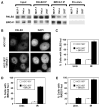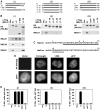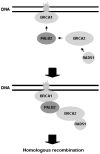PALB2 functionally connects the breast cancer susceptibility proteins BRCA1 and BRCA2
- PMID: 19584259
- PMCID: PMC4928587
- DOI: 10.1158/1541-7786.MCR-09-0123
PALB2 functionally connects the breast cancer susceptibility proteins BRCA1 and BRCA2
Abstract
BRCA1 and BRCA2 are prominently associated with inherited breast and ovarian cancer. The encoded proteins function in DNA damage responses, but no functional link between BRCA1 and BRCA2 has been established. We show here that PALB2 physically and functionally connects BRCA1 and BRCA2 into a DNA damage response network that also includes the RAD51 recombinase. PALB2 directly binds BRCA1, as determined with bacterially expressed fragments of each protein. Furthermore, PALB2 independently interacts with BRCA1 and BRCA2 through its NH2 and COOH termini, respectively. Critically, two point mutants (L21P and L24P) of the PALB2 coiled-coil domain or an NH2-terminal deletion (Delta1-70) disrupt its interaction with BRCA1. We have reconstituted PALB2-deficient cells with PALB2Delta1-70, PALB2-L21P, or PALB2-L24P, or with COOH-terminally truncated PALB2 that is deficient for interaction with BRCA2. Using extracts from these cells, we find that PALB2 mediates the physical interaction of BRCA2 with a COOH-terminal fragment of BRCA1. Analysis of the assembly of foci in these cells by BRCA1, PALB2, BRCA2, and RAD51 suggests that BRCA1 recruits PALB2, which in turn organizes BRCA2 and RAD51. Resistance to mitomycin C and the repair of DNA double-strand breaks by homologous recombination require the interaction of PALB2 with both BRCA1 and BRCA2. These results suggest that BRCA1 and BRCA2 cooperate in DNA damage responses in a PALB2-dependent manner, and have important implications for the genesis of breast/ovarian cancer and for chemotherapy with DNA interstrand cross-linking agents.
Conflict of interest statement
No potential conflicts of interest were disclosed.
Figures





References
-
- Miki Y, Swensen J, Shattuck-Eidens D, et al. A strong candidate for the breast and ovarian cancer susceptibility gene BRCA1. Science (New York NY) 1994;266:66–71. - PubMed
-
- Wooster R, Neuhausen SL, Mangion J, et al. Localization of a breast cancer susceptibility gene, BRCA2, to chromosome 13q12–13. Science (New York, NY) 1994;265:2088–90. - PubMed
-
- Wooster R, Bignell G, Lancaster J, et al. Identification of the breast cancer susceptibility gene BRCA2. Nature. 1995;378:789–92. - PubMed
-
- Hall JM, Lee MK, Newman B, et al. Linkage of early-onset familial breast cancer to chromosome 17q21. Science (New York, NY) 1990;250:1684–9. - PubMed
-
- Gudmundsdottir K, Ashworth A. The roles of BRCA1 and BRCA2 and associated proteins in the maintenance of genomic stability. Oncogene. 2006;25:5864–74. - PubMed
MeSH terms
Substances
Grants and funding
LinkOut - more resources
Full Text Sources
Other Literature Sources
Molecular Biology Databases
Research Materials
Miscellaneous

